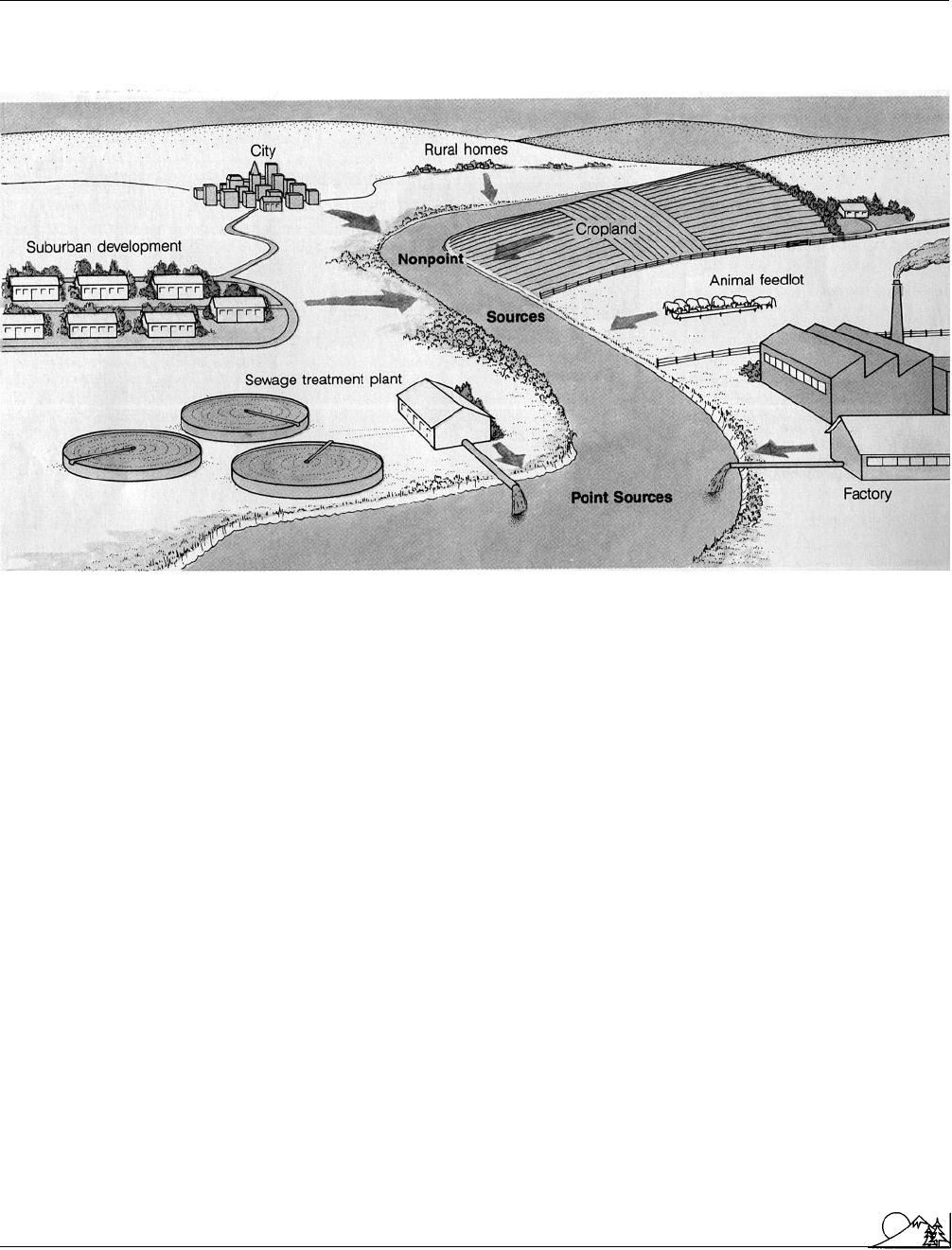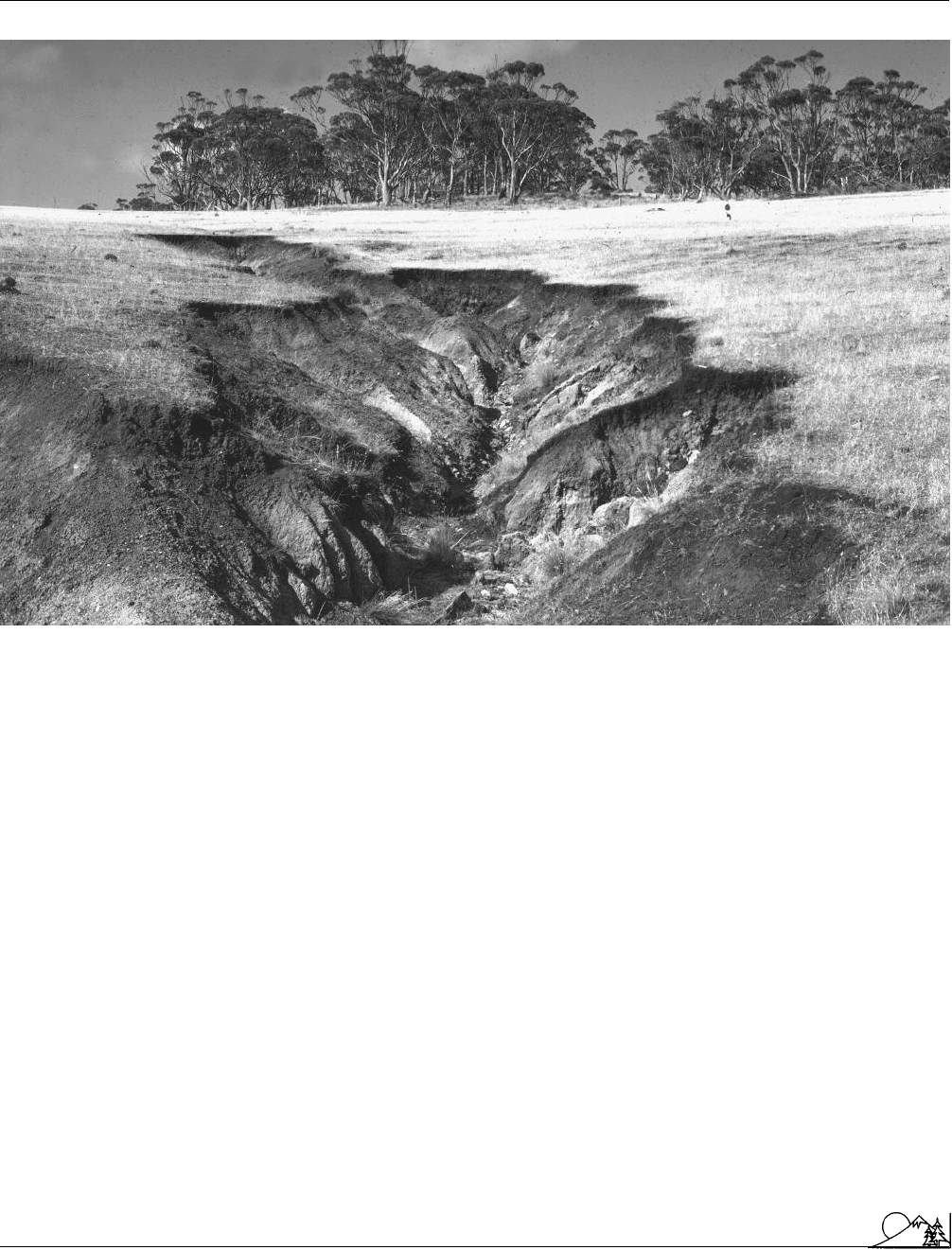Environmental Encyclopedia
Подождите немного. Документ загружается.


Environmental Encyclopedia 3
Grizzly bear
A grizzly bear (
Ursus arctos
). (Reproduced by permission.)
February, or March, and are small (less than 1 lb/0.45 kg)
and helpless. They remain in the den for three or four months
before emerging, and stay with their mother for one and a
half to four years. The age at which a female first reproduces,
litter size, and years between litters are determined by nutri-
tion, which induces females to establish foraging territories
which exclude other females. These territories range from
10–75 mi
2
(26–194 km
2
). Males tend to have larger ranges
extending up to 400 mi
2
(1,036 km
2
) and incorporate the
territories of several females. Young females, however, often
stay within the range of their mother for some time after
leaving her care, and one case was reported of three genera-
tions of female grizzly bears living within the same range.
Grizzly bear populations have been decimated over
much of their original range.
Habitat
destruction and
hunt-
ing
are the primary factors involved in their decline. The
North American population, particularly in the lower 48
states, has been extremely hard hit. Grizzly bears numbered
near 100,000 in the lower 48 states as little as 180 years ago,
but, today, fewer than 1,000 remain on less than 2% of their
original range. This population has been further fragmented
into seven small, isolated populations in Washington, Idaho,
677
Montana, Wyoming, and Colorado. This decline and frag-
mentation makes their potential for survival tenuous. The
U. S.
Fish and Wildlife Service
considers the grizzly bear
to be threatened in the lower 48 states.
Little has been done to protect this declining species
in the lower 48 states. In 1999 it was agreed to begin
slowly reintroducing grizzlies into the 1.2 million acre
(49,000 ha) area of the Selway-Bitterroot Wilderness on
the border of Idaho and Montana. Unfortunately, the
project was put on hold as of 2001 due to unfounded
fear of the animal. Habitat loss due to timbering, road
building, and development in this region is still a major
problem and will continue to impact these threatened
populations of bears.
[Eugene C. Beckham]
R
ESOURCES
B
OOKS
Nowak, R. M., ed. Walker’s Mammals of the World 5th ed. Baltimore: Johns
Hopkins University Press, 1991.

Environmental Encyclopedia 3
Groundwater
P
ERIODICALS
“Interior Department Caves in to Grizzly Bear Scare.” USA Today, August
6, 2001.
O
THER
Craighead Environmental Research Institute. [cited May 2002]. <http://
www.grizzlybear.org>.
“New Grizzly Bear Recovery Plan: Bad News for Bears.” Wild Forever, 1993.
Groundwater
Groundwater occupies the void space in a geological strata.
It is one element in the continuous process of moisture
circulation on Earth, termed the
hydrologic cycle
.
Almost all groundwater originates as surface water.
Some portion of rain hitting the earth runs off into streams
and lakes, and another portion soaks into the
soil
, where it
is available for use by plants and subject to evaporation back
into the
atmosphere
. The third portion soaks below the
root zone and continues moving downward until it enters
the groundwater. Precipitation is the major source of
groundwater. Other sources include the movement of water
from lakes or streams and contributions from such activities
as excess
irrigation
and
seepage
from canals. Water has
also been purposely applied to increase the available supply
of groundwater. Water-bearing formations called aquifers
act as reservoirs for storage and conduits for transmission
back to the surface.
The occurrence of groundwater is usually discussed by
distinguishing between a
zone of saturation
and a zone of
aeration
. In the zone of saturation the pores are entirely
filled with water, while the zone of aeration has pores that
are at least partially filled by air. Suspended water does occur
in this zone. This water is called vadose, and the zone of
aeration is also known as the
vadose zone
. In the zone of
aeration, water moves downward due to gravity, but in the
zone of saturation it moves in a direction determined by the
relative heights of water at different locations.
Water that occurs in the zone of saturation is termed
groundwater. This zone can be thought of as a natural storage
area of
reservoir
whose capacity is the total volume of the
pores of openings in rocks.
An important exception to the distinction between
these zones is the presence of ancient sea water in some
sedimentary formations. The pore spaces of materials that
have accumulated on an ocean floor, which has then been
raised through later geological processes, can sometimes con-
tain salt water. This is called connate water.
Formations or strata within the saturated zone from
which water can be obtained are called aquifers. Aquifers
must yield water through
wells
or springs at a rate that can
serve as a practical source of water supply. To be considered
678
an
aquifer
the geological formation must contain pores or
open spaces filled with water, and the openings must be
large enough to permit water to move through them at a
measurable rate. Both the size of pores and the total pore
volume depends on the type of material. Individual pores
in fine-grained materials such as clay, for example, can be
extremely small, but the total volume is large. Conversely,
in coarse material such as sand, individual pores may be
quite large but total volume is less. The rate of movement
from fine-grained materials, such as clay, will be slow due
to the small pore size, and it may not yield sufficient water
to wells to be considered an aquifer. However, the sand is
considered an aquifer even though they yield a smaller vol-
ume of water because, they will yield water to a well.
The
water table
is not stationary but moves up or
down depending on surface condition such as excess precipi-
tation,
drought
, or heavy use. Formations where the top of
the saturated zone or water table define the upper limit of
the aquifer are called unconfined aquifers. The hydraulic
pressure at any level with an aquifer is equal to the depth
from the water table, and there is a type known as a water-
table aquifer, where a well drilled produces a static water
level which stands at the same level as the water table.
A local zone of saturation occurring in an aerated zone
separated from the main water table is called a perched water
table. These most often occur when there is an impervious
strata or significant particle-size change in the zone of aera-
tion which causes the water to accumulate. A confined aqui-
fer is found between impermeable layers. Because of the
confining upper layer, the water in the aquifer exists within
the pores at pressures greater than the atmosphere. This is
termed an artesian condition and gives rise to an
artesian
well
.
Groundwater has always been an important resource,
and it will become more so in the future as the need for good
quality water increases due to urbanization and agricultural
production. It has recently been estimated that 50% of the
drinking water in the United States comes from ground-
water; 75% of the nation’s cities obtain all or part of their
supplies from groundwater, and rural areas are 95% depen-
dent upon it. For these reasons, it is widely believed that
every precaution should be taken to protect groundwater
purity. Once contaminated, groundwater is difficult, expen-
sive, and sometimes impossible to clean up. The most preva-
lent sources of contamination are waste disposal, the storage,
transportation
and handling of commercial materials, min-
ing operations, and nonpoint sources such as agricultural
activities. See also Agricultural pollution; Aquifer restoration;
Contaminated soil; Drinking water supply; Safe Drinking
Water Act; Water quality; Water table draw-down
[James L. Anderson]

Environmental Encyclopedia 3
Groundwater pollution
R
ESOURCES
B
OOKS
Collins, A. G., and A. I. Johnson, eds. Ground-Water Contamination: Field
Methods. Philadelphia: American Society for Testing and Materials, 1988.
Davis, S. N., and R. J. M. DeWiest. Hydrogeology. New York: Wiley, 1966.
Fairchild, D. M. Ground Water Quality and Agricultural Practices. Chelsea,
MI: Lewis, 1988.
Freeze, R. A., and J. A. Cherry Ground Water. Englewood Cliffs, NJ:
Prentice-Hall, 1979.
Ground Water and Wells. St. Paul: Edward E. Johnson, 1966.
Groundwater monitoring
Monitoring
groundwater
quality and
aquifer
conditions
can detect contamination before it becomes a problem. The
appropriate type of monitoring and the design of the system
depends upon
hydrology
,
pollution
sources, and the popu-
lation density and
climate
of the region. There are four
basic types of groundwater monitoring systems: ambient
monitoring, source monitoring, enforcement monitoring,
and research monitoring.
Ambient monitoring involves collection of background
water quality
data for specific aquifers as a way to detect
and evaluate changes in water quality. Source monitoring is
performed in an area surrounding a specific, actual, or poten-
tial source of contamination such as a
landfill
or spill site.
Enforcement monitoring systems are installed at the direc-
tion of regulatory agencies to determine or confirm the origin
and concentration gradients of contaminants relative to regu-
latory compliance. Research monitoring
wells
are installed
for detection and assessment of cause and effect relationships
between groundwater quality and specific
land use
activities.
See also Aquifer restoration; Contaminated soil; Drinking-
water supply; Hazardous waste siting; Leaching; Water qual-
ity standards
Groundwater pollution
When contaminants in
groundwater
exceed the levels
deemed safe for the use of a specific
aquifer
use the ground-
water is considered polluted. There are three major sources
of groundwater
pollution
. These include natural sources,
waste disposal activities, and spills, leaks, and
nonpoint
source
activities such as agricultural management practices.
All groundwater naturally contains some dissolved
salts or minerals. These salts and minerals may be leached
from the
soil
and from the aquifer materials themselves and
can result in water that poses problems for human consump-
tion, is considered polluted, or does not meet the
secondary
standards
for
water quality
. Natural minerals or salts that
679
may result in polluted ground water include chloride, nitrate,
fluoride, iron and sulfate.
There are currently no feasible methods for the large-
scale disposal of waste that do not have the potential for
serious pollution of the
environment
, and there are a num-
ber of waste-disposal practices the specifically threaten
groundwater. These include activities which range from sep-
arate
sewage treatment
systems for individual residences,
used by 30% of the population in the United States, to
the storage and disposal of industrial wastes. Many of the
problems posed by industrial waste arise from the use of
surface storage facilities that rely on evaporation for disposal.
These facilities are also known as
discharge
ponds, and
there are other types in which waste is treated to standards
suitable for discharge to surface water. But in the use of
both facilities the potential exists for the movement of con-
taminants into groundwater. Many of the numerous sanitary
landfills in the country are in the same situation. Water
moving down and away from these sites into groundwater
aquifers carries with it a variety of
chemicals
leached from
the material deposited in the landfills. The liquid that moves
out of landfills is called leachate.
Agricultural practices also contribute to groundwater
pollution, and there have been increases in nitrate concentra-
tions and low-level concentrations of pesticides. For control
of groundwater pollution, one of the most important agricul-
tural practices is the management of
nitrogen
from all
sources--fertilizer, nitrogen fixing plants, and
organic
waste
. Once nitrogen is in the nitrate form it is subject to
leaching
, so it is important that the amount applied not
exceed the crops’ ability to use it. At the same time crops
need adequate nitrogen to obtain high yields, and a good
balance must be maintained. Low-level
pesticide
contami-
nation occurs in areas where aquifers are sensitive to surface
activity, particularly areas of shallow aquifers beneath rapidly
permeable
soils, and regions of “karst”
topography
where
deep and wide range pollution can occur due to fractures in
the bedrock.
Except in cases of
deep-well injection
waste or sub-
stances contained in sanitary landfills, most contaminants
move from the land surface to aquifers. The water generally
moves through an unsaturated zone, in which biological
and chemical processes may act to degrade or change the
contaminant. Plant uptake can also act to reduce some of
the pollution. Once in the aquifer, how the contaminant
moves with the water will depend the solubility of the com-
pound, and the speed of contamination will depend on how
fast water moves through the aquifer. Chemical and biologi-
cal degradation of contaminants can occur in the aquifer,
but usually at a slower rate than it does on the surface due
to lower temperatures, less available oxygen, and reduced
biological activity. In addition aquifer contaminants exist in

Environmental Encyclopedia 3
Groundwater pollution
Sources of groundwater pollution. (McGraw-Hill Inc. Reproduced by permission.)
lower concentrations, diluted by the large water volume.
Most pollution remains relatively localized in aquifers, since
movement of the contaminants usually occurs in plumes that
have definite boundaries and do not mix with the rest of
the water. This does provide an advantage for isolation and
treatment.
The types of chemicals that pollute groundwater are
as varied as their sources. They range from such simple
inorganic materials as nitrate from fertilizers, septic tanks,
and
feedlots
, chloride from high salt, and
heavy metals
such as chromium from metal plating processes, to very
complex organic chemicals used in manufacturing and
household cleaners.
One of the main criteria in judging risk is public health.
Acute effects
from immediate exposure to a concentrated
product is often well documented, but little written evidence
exists to link physiological effects with long-term chronic
exposure. About all that is available are epidemiological data
that suggest possible effects, but are by no means conclusive.
Environmental effects are even less well understood, but
some have suggested that the best way to determine the
potential danger is to look at how long a substance persists.
680
Those that remain the longest are most likely to pose long-
term risks.
The most efficient way to protect groundwater is to
limit activities in recharge areas. For confined aquifers it
may be possible to control activities that can result in pollu-
tion, but this is extremely difficult for unconfined aquifers
which are essentially open systems and subject to effects
from any land activity. In areas of potential salt-water intru-
sion excess pumping can be regulated, and this can also be
done where water is being used for
irrigation
faster than the
recharge rate, so that the water is becoming saline. Another
important activity for the protection of groundwater is the
proper sealing of all
wells
that are not currently being used.
Classification of aquifers according to their predomi-
nant use is another management tool now employed in a
number of states. This establishes water-quality goals and
standards for each aquifer, and means that aquifers can be
regulated according to their major use. This protects the
most valuable aquifers, but leaves the problem of predicting
future needs. Once an aquifer is contaminated, it is very
expensive if not impossible to restore, and this management
tool may have serious drawbacks in the future.

Environmental Encyclopedia 3
Growth limiting factors
In rural areas of the United States, 95% of the popula-
tion draws their drinking water from the groundwater supply.
With a growing population, continued industrialization, and
increasing agricultural reliance on the use of chemicals, many
believe it is now more important than ever to protect ground-
water. Contamination problems have been encountered in
every state, but prevention is far more efficient and effective
than restoration after damage has been done. Prevention
can be achieved through regional planning and enforcement
of state and federal regulations. See also Agricultural pollu-
tion; Aquifer restoration; Contaminated soil; Drinking-
water supply; Feedlot runoff; Groundwater monitoring;
Hazardous waste site remediation; Hazardous waste siting;
Heavy metals and heavy metal poisoning; Waste manage-
ment; Water quality; Water quality standards; Water
treatment
[James L. Anderson]
R
ESOURCES
B
OOKS
Freeze, R. A., and J. A. Cherry. Ground Water. Englewood Cliffs, NJ:
Prentice-Hall, 1979.
Pye, V. I., R. Patrick, and J. Quarles. Ground Water Contamination in the
United States. Philadelphia: University of Pennsylvania Press, 1983.
P
ERIODICALS
Hallberg, G. R. “From Hoes to Herbicides: Agriculture and Groundwater
Quality.” Journal of Soil and Water Conservation (November-December
1986): 358–59.
Growth curve
A graph in which the number of organisms in a population
is plotted against time. Such curves are amazingly similar
for populations of almost all organisms from bacteria to
human beings and are considered characteristic of popula-
tions.
Growth curves typically have a sigmoid or S-shaped
curve. When a few individuals enter a previously unoccupied
area, growth is at first slow during the positive acceleration
phase. The growth then becomes rapid and increases expo-
nentially, called the logarithmic phase. The growth rate
eventually slows down as environmental
resistance
gradu-
ally increases; this phase is called the negative acceleration
phase. It finally reaches an equilibrium or saturation level.
The final stage of the growth curve is termed the
carrying
capacity
of the
environment
.
A good example of a species’ growth curve is demon-
strated by the sheep population in Tasmania. Sheep were
introduced into Tasmania in 1800. Careful records of their
numbers were kept, and by 1850 the sheep population had
681
reached 1.7 million. The population remained more or less
constant at this carrying capacity for nearly a century.
The figures used to plot a growth curve—time and
the total number in the population—vary from one
species
to another, but the shape of the growth curve is similar for
all populations. Once a population has become established
in a certain region and has reached the equilibrium level,
the numbers of individuals will vary from year to year de-
pending on various environmental factors. Comparing these
variations for different species living in the same region is
helpful to scientists who manage
wildlife
areas or who track
factors that affect populations.
For example, a study of the population variations of
the snowshoe hare and the lynx (Lynx canadensis) in Canada
is a classic example of species interaction and interdepen-
dence. The peak of the hare population comes about a year
before the peak of the lynx population. Since the lynx feeds
on the hare, it is obvious that the lynx cycle is related to the
hare cycle. This leads to a decline in the population of hares
and secondarily to a decline in the lynx population. This
permits the plants to recover from the overharvesting by the
hares, and the cycle can begin again.
Growth curves are just one of the characteristics of
populations. Other characteristics that are a function of the
whole group and not of the individual members include
population density, birth rate, death rate, age distribution,
biotic potential, and rate of dispersion. See also Population
growth
[Linda Rehkopf]
Growth, exponential
see
Exponential growth
Growth limiting factors
There are a number of essential conditions which all organ-
isms, both plants and animals, require to grow. These are
known as growth factors. Plants, for example, require sun-
light, water, and
carbon dioxide
in order to perform
photo-
synthesis
. They require nutrients such as
nitrogen
,
phos-
phorus
, and various trace elements in order to form tissues.
The
environment
in which the plant is growing does not
contain a unlimited supply of these growth factors. When
one or more of them is present in levels or concentrations
low enough to constrain the growth of the plant, it is known
as a growth limiting factor. The rate or magnitude of the
growth of any organism is controlled by the growth factor
that is available in the lowest quantities. This concept is
analogous to the saying that a chain is only as strong as its
weakest link.

Environmental Encyclopedia 3
Guano
These factors limit
population growth
. If they did
not exist, a population could increase exponentially, limited
only by its own intrinsic lifespan. Growth limiting factors
are essential to the traditional concept of
carrying capacity
,
which rests on the assumption that the available resources
limit the population that can be sustained in that area. Ad-
vances in technology have enabled people to increase the
carrying capacity in certain areas by manipulating the growth
limiting factors. Perhaps the best example of this is the use
of fertilizers on farmland.
In the field of population
ecology
, identifying growth
limiting factors is part of establishing the constraints and
pressures on populations and predicting growth in various
conditions. Algal growth in New York Harbor provides an
example of the importance of identifying growth limiting
factors. In New York Harbor, several billion gallons of un-
treated
wastewater
are released daily, bringing enormous
quantities of nutrients and suspended solids into the water.
Algae in the harbor take advantage of the
nutrient
loads
and grow more than they would under nutrient-poor condi-
tions. At the same time, however, the suspended solids and
silts brought into harbor cause the water to become very
turbid, limiting the amount of sunlight that penetrates it.
Sunlight is rarely a growth limiting factor for algae; nutrients
are usually what limits their growth, but in this case nutrients
are in excess supply. This means that if
pollution control
in the harbor ever results in control of the turbidity in the
water, there will probably be a sharp increase in the growth
of algae.
Consideration of growth limiting factors is also very
important in the field of
conservation biology
and
habitat
protection. If the goal is to protect a bird such as the heron,
which may feed on fish from a lake and nest in upland trees
nearby, limiting factors must be taken into account not only
for the growth of the individual but also for the population.
Conservation
efforts must not be directed only toward en-
suring there are enough fish in the lake. Enough trees must
also be left uncut and undisturbed for nesting in order to
address all of the growth requirements for the population.
Regardless of how abundant the fish are, the number of
herons will only grow to the extent allowed by the number
of available nesting sites.
Environmentalists use growth limiting factors to dis-
tinguish between undisturbed ecosystems and unstable or
stressed systems. In an
ecosystem
that has been distressed
or disturbed, the nature of growth limiting factors changes,
and these changes are often human-induced, as they are in
New York Harbor. Though the change in circumstances
may not always appear negative in impact, it still represents
a shift away from the original balance, and it may have
effects on other
species
or lead to subtle long-term changes
in the system. Any cleanup or management strategy must
682
use these new growth limiting factors to identify the nature
of the imbalance that has occurred and develop a procedure
to restore the system to its original condition.
Growth limiting factors are extensively used in the
field of
bioremediation
, in which
microbes
are used to
clean up environmental contaminants by breakdown and
decomposition
.
Oil spills
are a good example. Bacteria that
can break down and degrade oils are naturally present in
small quantities in
soil
, but under normal conditions their
growth is limited by both the availability of essential nutri-
ents and the availability of oil. In the event of an oil spill
on land, the only growth limiting factor for these bacteria
is nutrients. Bioremediation scientists can add nitrogen and
phosphorus to the soil in these circumstances to stimulate
growth, which increases degradation of the oil. Techniques
such as these, which use naturally occurring bacterial popula-
tions to control contamination, are still in development; they
are most useful when the contaminants are present in high
concentrations and confined to a limited area. See also Algal
bloom; Decline spiral; Ecological productivity; Exponential
growth; Food chain/web; Restoration ecology
[Usha Vedagiri and Douglas Smith]
R
ESOURCES
B
OOKS
Mayer, G. Ecological Stress and the New York Bight: Science and Management.
Columbia, SC: Estuarine Research Federation, 1982.
Smith, R. L. Ecology and Field Biology. New York: Harper and Row Publish-
ers, 1980.
Growth, logistic
see
Logistic growth
Growth, population
see
Population growth
Grus americana
see
Whooping crane
Guano
Manure created by flying animals that is deposited in a
central location because of nesting habits. Guano can occur
in caves from
bats
or in nesting grounds where large popula-
tions of birds congregate. Guano was frequently used as a
source of
nitrogen fertilizer
prior to the time when nitrogen
fertilizer was commercially manufactured from
natural gas
.
See also Animal waste

Environmental Encyclopedia 3
Guinea worm eradication
Guinea worm eradication
In 1986, the world health community began a campaign to
eliminate the guinea worm (Dracunculus medinensis) from
the entire world. If successful, this will be only the second
global disease ever completely eradicated (smallpox, which
was abolished in 1977 was first), and the only time that a
human parasite will have been totally exterminated world-
wide. Known as the fiery serpent, the guinea worm has been
a terrible scourge in many tropical countries. Dracunculiasis
(pronounced dra-KUNK-you-LIE-uh-sis) or guinea worm
disease starts when people drink stagnant water contami-
nated with tiny copepod water fleas (called cyclops) con-
taining guinea worm larvae. Inside the human body, the
worms grow to as long as 3 ft (1 m). After a year of migrating
through the body, a threadlike adult worm emerges slowly
through a painful skin blister. Most worms come out of the
legs or feet but they can appear anywhere on the body. The
eight to 12 weeks of continuous emergence are accompanied
by burning pain, fever, nausea, and vomiting. Many victims
bathe in a local pond or stream to soothe their fever and
pain. When the female worm senses water, she releases tens
of thousands of larvae, starting the cycle once again. Once
the worms become established in local ponds, infections
among people living nearby are at high risk for further infec-
tions.
As the worm emerges from the wound, it can be rolled
around small stick and pulled out a few centimeters each
day. Sometimes the entire worm can be extracted in a few
days, but the process usually takes weeks. Unfortunately, if
you pull too fast and the worm breaks off, the part left in
your body can die and fester, leading to serious secondary
infections. If the worm comes out through a joint, permanent
crippling can occur. There is no cure for guinea worm disease
once the larvae are ingested. There is no vaccine, and having
been infected once doesn’t give you immunity. Many people
in affected villages suffer the disease repeatedly year after
year. The only way to break the cycle is through behavioral
changes. Community health education, providing clean
water from
wells
or by filtering or boiling drinking water,
eliminating water fleas by chemical treatment, and teaching
infected victims to stay out of drinking supplies are the only
solutions to this dreadful problem.
Although people rarely die as a direct effect of the
parasite, the social and economic burden at both the individ-
ual and community level is great. During the weeks that
worms are emerging, victims usually are unable to work or
carry out family duties. This debilitation often continues for
several months after worms are no longer visible. In severe
cases, arthritis-like conditions can develop in infected joints,
and the patient may be permanently crippled.
683
When the eradication campaign was started in 1986,
guinea worms were endemic to 16 countries in sub-Saharan
Africa as well as Yemen, India, and Pakistan. Every year
about 3.5 million people were stricken and at least 100
million people were at risk. With the leadership of former
U.S. President Jimmy Carter, a consortium of agencies, insti-
tutions, and organizations—the World Health Organization
(WHO), UNICEF, the United Nations Development Pro-
gram (UNDP), the
World Bank
, bilateral aid agencies, and
the governments of many developed countries—banded to-
gether to fight this disease. Although complete success has
not yet occurred, encouraging progress has been made. Al-
ready the guinea worm infections are down more than 96%.
Pakistan was the first formerly infested country to be declared
completely free of these
parasites
. Infection rates in Kenya,
Senegal, Cameroon, Chad, India, and Yemen are down
below 100 cases per year. More than 80% of all remaining
cases occur in Sudan, where civil war, poverty,
drought
, and
governmental
resistance
to outside aid have made treatment
difficult.
An encouraging outcome of this crusade is the demon-
stration that public health education and community organi-
zation can be effective, even in some of the poorest and most
remote areas. Village-based health workers and volunteers
conduct disease surveillance and education programs,
allowing funds and supplies to be distributed in an efficient
manner. Once people understand how the disease spreads
and what they need to do to protect themselves and their
families, they do change their behavior. A great advantage
of this community health approach is educating villagers
about the importance of proper
sanitation
and clean drink-
ing water is effective not only against dracunculiasis, but
also can help eliminate
malaria
, shistosomiasis, and many
other water-borne diseases.
[William P. Cunningham Ph.D.]
R
ESOURCES
O
THER
The Carter Center. Eradicating Guinea Worm Disease. 2002 [cited July 9,
2002]. <http://www.cartercenter.org/healthprograms>.
Center for Disease Control. Fact Sheets: Dracunculiasis (Guinea Worm Dis-
ease). January 2001 [cited July 9, 2002]. <http://www.cdc.gov/ncidod/dvrd/
spb/mnpages/dispages/dracuculiasis.html>.
UNICEF. Guinea Worm in Retreat. March/April 1995 [cited July 9, 2002].
<http://www.unicef.org/pon95/heal0013.html>.
O
RGANIZATIONS
The Carter Center, One Copenhill 453 Freedom Parkway, Atlanta, GA
USA 30307 Email: carterweb@emory.edu, http://www.cartercenter.org

Environmental Encyclopedia 3
Gulf War syndrome
Gulf War syndrome
Approximately 697,000 U.S. service members were deployed
to the Persian Gulf from January to March 1991 as part of
a multinational effort to stop Iraq’s attack against Kuwait.
And while the war itself was short, a long battle has been
taking place ever since by veterans, the government and
scientists to determine what has caused “Gulf War Syn-
drome,” a mysterious collection of symptoms reported by as
many as 70,000 U.S. men and women who served in the
war. They are joined by British veterans in their health
complaints, and in smaller numbers by Canadians, Czechs,
and Slovaks.
Gulf War Syndrome is a complex array of symptoms,
including chronic fatigue, rashes, headaches, diarrhea, sleep
disorders, joint and muscle pain, digestive problems, memory
loss, difficulty concentrating, and depression. A small per-
centage of veterans have had babies born with twisted limbs,
congestive heart failure, and missing organs. The veterans
blamed these abnormalities on their service in the Gulf. The
U.S.
Environmental Protection Agency
(EPA) has also
found high rates for brain and nervous system cancers among
these veterans, up to seven to 14 times higher than among
the general population, depending on the age group. Consid-
ering that most soldiers and veterans are younger and in
better physical shape than the general population, researchers
find such figures more than surprising.
Collectively, these ailments suggest that neurological
processes may have been altered, or immune systems dam-
aged. While no single cause has been identified, various
analyses of the Gulf War experience point to low-level expo-
sure of chemical weapons, combined with other environmen-
tal and medical factors, as key contributors to the health
problems triggered years after exposure.
The war was unique in the levels of physical and emo-
tional stresses created for those who served, as well as for
their families. A significant portion of troops were from the
reserves, rather than active enlistees. Deployment occurred
at unprecedented speed. Most troops were given multiple
vaccinations that singularly do not have adverse effects; their
combined effects were not tested before distribution. Detec-
tors often signaled the presence of chemical weapons during
the conflict, but were mostly ignored as inaccurate. The
soldiers worked long hours in extreme temperatures, lived
in crowded and unsanitary conditions where pesticides were
used indiscriminately to rid areas of flies, snakes, spiders,
and scorpions, and breathed and had dermal exposures to
chemicals
from the continuous oil fires—burning trash,
feces, fuels, and solvents. Blazing sun, blowing sand and
biting sandflies further increased the discomfort and stress
of military life in the
desert
. Exposures to the various fumes
often exceeded federal standards and World Health Organi-
684
zation health guidelines; these alone could have caused “per-
manent impairment,” according to a 1994 National Institutes
of Health report.
The U.S. military now admits it was inadequately
prepared for chemical and biological warfare, which it knew
Iraq had previously used. Three of four reserve units, for
example, didn’t have protective gear. The drug pyridostig-
mine bromide (PB, 3-dimethylaminocarbonyloxy-N-meth-
ylpyridium bromide) was given to almost 400,000 troops
before and during the Gulf War to combat the effects of
nerve gas, even though it is approved by the
Food and Drug
Administration
(FDA) only for treatment of the neurologi-
cal disorder myasthenia gravis. The FDA agreed on the
condition that commanders inform troops what they were
taking and what the potential side effects were. One survey,
however, found that 63 of 73 veterans who had taken the
drug did not receive such information. Records were not
kept on who took which drugs or vaccines, as required by
FDA and Defense Department guidelines.
While the Defense Department and other government
agencies have spent more than $80 million to try to identify
the cause of veterans’ ailments, a privately funded team of
toxicologists and epidemiologists may have discovered an
explanation for at least some problems experienced by Gulf
War veterans. Researchers treated chickens in 1996 with
nonlethal doses of three chemicals veterans were exposed to:
DEET (N,N-diethyl-m-toluamide) and chlorpyrifos (O,O-
diethyl O-3,5,6-trichloropyridinyl phosphorothioate), used
topically or sprayed on uniforms as insecticides, and the anti-
nerve gas drug pyridostigmine bromide. They found that
simultaneous exposure to two or more of the insecticides
and drugs damaged the chickens’ nervous system, even
though none of the chemicals caused problems by itself. The
range of symptoms the chickens developed is similar to
those the veterans describe. A similar study by the Defense
Department found that the chemicals were more toxic to
rats when given together than individually. Follow up studies
are underway to determine if this also holds for humans.
The researchers hypothesize that multiple chemicals
overwhelmed the animals’ ability to neutralize them. The
enzyme
butyrylcholinesterase, which circulates in the blood,
breaks down a variety of nitrogen-containing organic com-
pounds, including the three substances tested. But the anti-
nerve gas drug, in particular, can monopolize the enzyme,
preventing it from dealing with the insecticides. Those
chemicals could then sneak into the brain, and cause damage
they would not produce on their own.
Many veterans believe that, while the drugs and pesti-
cides may have played a role in their ailments, so have
chemical weapons. Troops could have been subjected to
much more low-level exposure of chemical weapons than
previously believed, either directly or via air plumes, because

Environmental Encyclopedia 3
Gulf War syndrome
75% of Iraq’s chemical weapons production capability, along
with 21 chemical weapons storage sites, were destroyed by
allied air raids.
In addition, U.S. battalions blew up an Iraqi arms
dump soon after the war was over, before many troops had
left the Gulf. Khamisiyah, an enormous ammunition storage
site, covered 20 mi
2
(50 km
2
) with 100 ammunition bunkers
and other storage facilities. Two large explosions were set
off, one on March 4 and a second on March 10, 1991.
Smaller demolition operations continued in the area through
most of April 1991.
While the site was not believed to have contained
chemical weapons at the time, the Defense Department
admitted in June 1996 that the complex had included nerve
and mustard gases. The Central Intelligence Agency also
admitted in April 1997 that it knew in 1986 that thousands
of mustard gas weapons had been stored at the Khamisiyah
depot, but the agency failed to include it on a list of suspected
sites provided to the Defense Department before the 1991
war, which led troops to assume it was safe to blow it up.
Weather data shows that upper-level winds in the gulf
were blowing in a southerly direction during and after the
bombing. Thus, vapors carried by these winds could have
contaminated troops hundreds of miles away. A 1974 report,
Delayed Toxic Effects of Chemical Warfare Agents, found that
chemicals weapons plant workers suffer as many chronic
symptoms as those now suffered by Gulf War veterans,
including neurological, gastrointestinal and heart problems,
loss of memory and a greater risk of
cancer
; exposure to
these chemicals may also create birth effects in children. A
1995 study by a British medical researcher found many of
the same symptoms in
Third World
people exposed to
or-
ganophosphate
insecticides, like DEET used in the Gulf
War, which are diluted versions of chemical weapons.
While British, Canadian and Slovak veterans have
reported similar ailments, albeit in smaller numbers, no
French veterans have complained of such illnesses, despite
extensive publicity. This is also providing valuable clues to
the U.S. veterans’ maladies, in several ways. For example,
the French did not use many of the vaccines that the British
and Americans used, including pyridostigmine bromide.
French camps were not sprayed with insecticides as a preven-
tive measure, rather only when needed to control
pest
popu-
lations. When they did spray, they did not use organophos-
phates. Finally, the French were nowhere near the
Khamisiyah munitions depot when the destruction occurred.
In February 1997, a series of study results established
the most definitive links between Gulf War syndrome and
chemicals to date. The research identifies six “syndromes,”
or clusters of like symptoms in discrete groups of veterans,
and associates each with distinct events during the war.
Troops who reported exposure to chemical weapons, for
685
example, are likely to suffer from confusion, balance prob-
lems, impotence and depression. Other sets of symptoms
correspond to the use of insect repellants and anti-nerve gas
drugs. While not conclusive, these findings will likely spur
further research into the effects of low-level exposure to
certain chemicals.
Such research was advocated by the presidential advi-
sory committee, a 12-member panel of veterans, scientists,
and health care and policy experts established in 1995. The
committee held 18 public meetings between August 1995
and November 1996 to investigate the nature of Gulf War
veterans’ illnesses, health effects of Gulf War risk factors,
and the government’s response to Gulf War illnesses. While
the committee’s final report in January 1997 concluded that
no single, clinically recognizable disease can be attributed
to Gulf War service, it recommended additional research
on the long-term health effects of low-level exposures to
chemical weapons, on the synergistic effects of pyridostig-
mine bromide with other Gulf War risk factors, and on the
body’s physical response to stress.
While the debate continues, the Veterans Affairs and
the Defense Departments are providing free medical help
to any veteran who believes he or she is suffering from
Gulf War Syndrome. In January 1997, President Clinton
proposed new regulations that would extend the time avail-
able to veterans to prove their disabilities are related to
Gulf War service from two to 10 years. He also initiated a
presidential review to ensure that in any future deployments
the health of service men and women and their families is
better protected.
Definitive answers as to the causes and treatments for
veterans’ ailments may be years away. What is clear is that
the complex biological, chemical, physical and psychological
stresses of the
Persian Gulf War
appear to have produced
a variety of complex adverse health effects. No single disease
or syndrome is apparent, but rather multiple illnesses with
overlapping symptoms and causes. If what had been consid-
ered acceptable trace levels of chemical agents in the war
environment
are found to be harmful, the U.S. military
will have to revamp the way it protects its forces against
even those tiny amounts. Tragically, that would mean that
not only did “friendly fire” account for nearly 25% of the
146 U.S. deaths, but also that allied actions were responsible
for the war’s most persistent and haunting pain.
[Sally Cole-Misch]
R
ESOURCES
P
ERIODICALS
Abou-Donia, M.B., et. al. “Increased Neurotoxicity Following Concurrent
Exposure to Pyridostigmine Bromide, DEET and Chlorpyrifos.” Funda-
mental and Applied Toxicology 34, no. 190 (1996): 201–.222.

Environmental Encyclopedia 3
Gullied land
Gully erosion in Australia. (Photograph by A. B. Joyce. Photo Researchers Inc. Reproduced by permission.)
Barry, J., and R. Watson. “Scent of War.” Newsweek, September 30, 1996,
38–39.
Cary, P., and M. Tharp. “The Gulf War’s Grave Aura.” U.S. News &
World Report, 121, no. 2, July 8, 1996, 38–39.
Cowley, G., and M. Hager. “Poisoned in the Gulf?” Newsweek 127, no.
18, April 29, 1996, 74.
———. “A Gulf War Cover-up?” Newsweek, November 11, 1996, 48–49.
“Darkness at Noon.” The Economist 342, no. 7999 (January 1, 1997): 71–74.
National Institutes of Health Technology Assessment Workshop Panel.
“The Persian Gulf Experience and Health.” Journal of the American Medial
Association 272, no. 5 (August 3, 1994): 391–395.
Pennisi, E. “Chemicals Behind Gulf War Syndrome.” Science 272, no. 5261
(April 26, 1996): 479–480.
Shenon, P. “CIA Says It Knew of Iraq Chemicals.” Detroit Free Press, April
10, 1997, 1–3A.
Thompson, M. “The Silent Treatment.” Time, 148, no. 28, December 23,
1996, 33–37.
Waldman, A. “Credibility Gulf.” The Washington Monthly, 28, no. 12,
December 1996, 28–35.
Gullied land
Areas where all diagnostic
soil
horizons have been removed
by flowing water, resulting in a network of V-shaped or U-
686
shaped channels. Generally, gullies are so deep that extensive
reshaping is necessary for most uses. They cannot be crossed
with normal farm machinery. While gullied land can occur
on any land, they are often most prevalent on loess, sandy,
or other soils with low cohesion. See also Erosion; Soil profile;
Soil texture
Gymnogyps californianus
see
California condor
Gypsy moth
The gypsy moth (Portheria dispar), a native of Europe and
parts of Asia, has been causing both ecological and economic
damage in the eastern United States and Canada since its
introduction in New England in the 1860s.
In 1869, french entomologist Leopold Trouvelet
brought live specimens of the insect to Medford, Massachu-
setts for experimentation with silk production. Several indi-
vidual specimens escaped and became an established popula-
